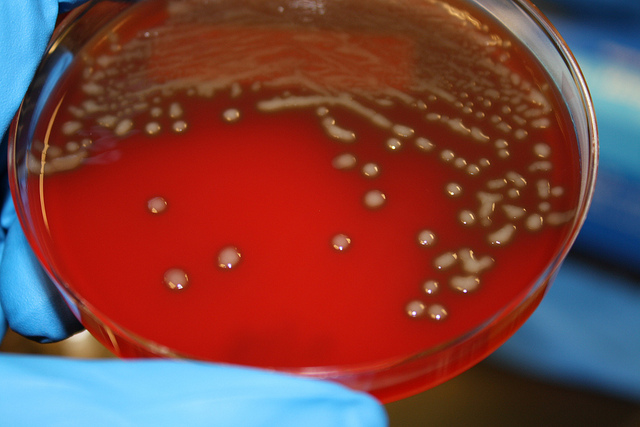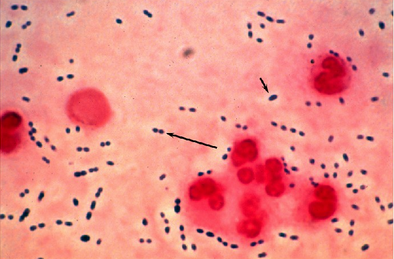The bacteria Streptococcus Pneumoniae was first discovered and isolated by Louis Pasteur in 1881. The term "Streptococcus Pneumoniae" originally comes from the Ancient Greek. "Strepto" means "twisted" and "coccos" originally meant "berry". The "pneumonia" part was named after the fact that the bacteria usually settles in the lungs and can often cause pneumonia. Because the bacteria usually comes in pairs, it is also known as Diplococcus Pneumoniae.
What Is Streptococcus Pneumoniae?
 Streptococcus Pneumoniae is a strain of bacteria that are usually shaped like slightly pointed cocci. They are often found in pairs, although it is also possible to find shorter chains and single cells. These bacteria are classified as alpha hemolytic, which refers to how they break down red blood cells. Individual Streptococcus Pneumoniae bacterium usually measures between 0.5 and 1.25 micrometers in diameter. Streptococcus Pneumoniae is non-motile and does not form or release spore, although it does have pili which are sometimes used for adherence, usually to a host's cells for better growth. Most typically, these bacteria are naturally found in the nasal and throat passages as well as the upper respiratory tract. They thrive best in temperatures of around 30 degrees Celsius.
Streptococcus Pneumoniae is a strain of bacteria that are usually shaped like slightly pointed cocci. They are often found in pairs, although it is also possible to find shorter chains and single cells. These bacteria are classified as alpha hemolytic, which refers to how they break down red blood cells. Individual Streptococcus Pneumoniae bacterium usually measures between 0.5 and 1.25 micrometers in diameter. Streptococcus Pneumoniae is non-motile and does not form or release spore, although it does have pili which are sometimes used for adherence, usually to a host's cells for better growth. Most typically, these bacteria are naturally found in the nasal and throat passages as well as the upper respiratory tract. They thrive best in temperatures of around 30 degrees Celsius.
What Is the Cell Structure of Streptococcus Pneumoniae?
 Typically, Streptococcus Pneumoniae is completely enclosed by polysaccharide capsules, which makes it such an effective virus. Its cell wall is made up of peptidoglycan, about six layers thick, and lipoteichoic acid which is attached to the membrane by a lipid moiety. This lipid moiety contains phosphorylcholine. Additionally, Streptococcus Pneumoniae has as many as 500 different surface proteins, including CBPs or choline-binding proteins. Twelve proteins from this family are connected to the choline moiety of the cell wall and they help the bacteria attach to other functional components on to the surface of the bacteria. It does not contain catalase, however, and, like other strands of streptococci, it has to ferment glucose in order to create lactic acid. Unlike other streptococci in the same family, Streptococcus Pneumoniae hydrolyzes insulin.
Typically, Streptococcus Pneumoniae is completely enclosed by polysaccharide capsules, which makes it such an effective virus. Its cell wall is made up of peptidoglycan, about six layers thick, and lipoteichoic acid which is attached to the membrane by a lipid moiety. This lipid moiety contains phosphorylcholine. Additionally, Streptococcus Pneumoniae has as many as 500 different surface proteins, including CBPs or choline-binding proteins. Twelve proteins from this family are connected to the choline moiety of the cell wall and they help the bacteria attach to other functional components on to the surface of the bacteria. It does not contain catalase, however, and, like other strands of streptococci, it has to ferment glucose in order to create lactic acid. Unlike other streptococci in the same family, Streptococcus Pneumoniae hydrolyzes insulin.
Most of the nitrogen and carbon that the bacteria get are gained through extracellular enzyme systems. These allow the metabolism of hexosamines and polysaccharides and also serve to damage host tissue which better enables colonization, making Streptococcus Pneumonia very effective when it finds a host.
What Diseases Can Streptococcus Pneumoniae Cause?
As previously mentioned, one of the most common diseases that is caused by the bacteria Streptococcus Pneumonia is pneumonia, a condition where a patient's lungs and the alveoli therein become inflamed due to infection. Pneumonia caused by this bacteria is broken up into four stages. During the first, the alveoli of the host's lung fill up with a serous fluid which scientists believe is stimulated by the Streptococcus Pneumoniae cell wall. The organisms contained within this fluid are then spread throughout the lungs, which leads to the second stage, in which neutrophils invade the alveoli. More red blood cells are also attracted to the site. During the third stage of pneumonia, macrophages eat away the remaining residue from the rush of blood to the area. If Streptococcus Pneumoniae is not found and stopped, it can persist in the lungs and then get into the blood stream, where it is easier for the bacteria to get into the brain and start infecting the meninges, causing meningitis.
Besides meningitis and pneumonia, there are a number of other diseases that are associated with Streptococcus Pneumonia, including sinusitis where the paranasal sinuses become infected, and otitis, the infected of the middle ear. Streptococcus Pneumoniae can also cause petonitis, the inflammation of the peritoneum, and arthritis.
How to Diagnose Streptococcus Pneumoniae Infections
In order to catch and, therefore, treat Streptococcus Pneumoniae, a gram stain must be performed on the sputum of the patient. The bacteria can be identified if neutrophils are present in the sample and if there are more than ten gram-positive diplococci. If the results of the test are inconclusive, or if further tests are required, the bacteria can be investigated further by being streaked onto blood agar. When this test is performed, the Streptococcus Pneumoniae should start to exhibit alpha-hemolysis, where the blood agar has areas of green coloring around the colonies of the bacteria that has been streaked onto the agar. However, this test is not always conclusive because other members of the Streptococcus bacteria exhibit similar reactions and can cause alpha-hemolysis. In order for this test to be conclusive, the streaked organisms should also exhibit sensitivity to optochin or bile, which can more conclusively prove that the bacteria is Streptococcus Pneumoniae.
How to Treat Streptococcus Pneumoniae Infections
Depending on how severe the infection is and how long someone has been suffering, there are a number of different treatments available for those who are suffering from an infection of Streptococcus Pneumoniae.
If the infection is extremely severe or has been going on for a long time, penicillin G is often administered to the patient, but for more minor infections, penicillin V is more commonly used. Unfortunately, more and more strains of Streptococcus Pneumoniae are now becoming more resistant to penicillin because this is the way it most commonly treated and it has adapted to be resistant to different types of penicillin. Since certain strains of Streptococcus Pneumoniae have developed a resistance to this method of treatment, it is entirely possible that other strains will soon start developing a similar resistance, which means scientists need to find an alternative treatment method. However, because Streptococcus Pneumoniae is naturally very fast growing and can create large cell densities in its infectious setting, its development or penicillin-resistant strains is very concerning.
Luckily, scientists are now working on developing Erythromycin as a cure for Streptococcus Pneumoniae infections, as it has been proved effective against strains of the bacteria that are resistant to penicillin.
Based on the information above, prevention is often better than cure in case of Streptococcus Pneumoniae, and luckily there is also a vaccine that is offered to help prevent Streptococcus Pneumoniae from invading and causing infections in the first place. The vaccine has a 23-valent capsular polysaccharide which can protect against the most common strains of the bacteria. However, because there are so many different types (over 90 different strains at least) and it is evolving all the time, the vaccine is not effective against all strain, and it is still possible to suffer from Streptococcus Pneumoniae infections even after having had the vaccine.
